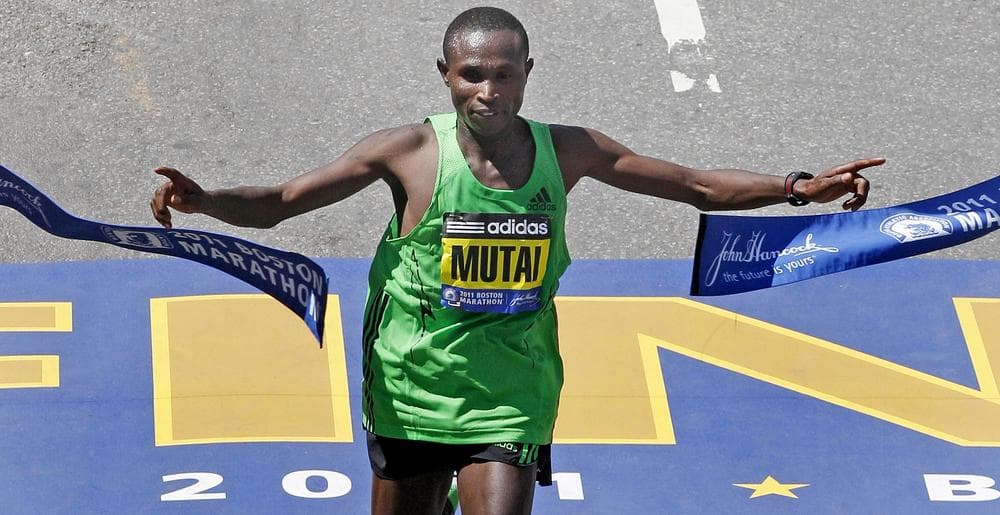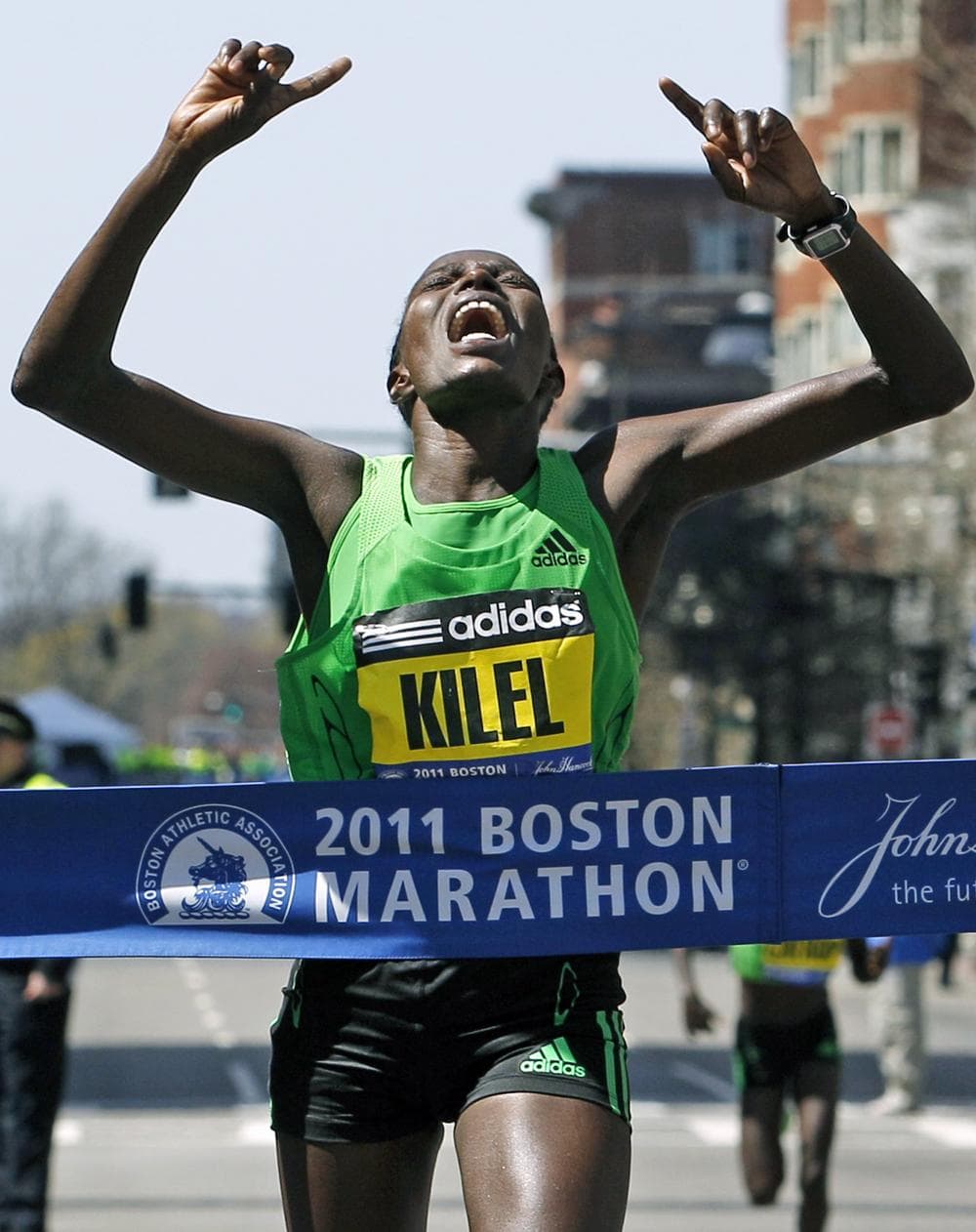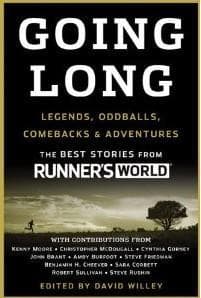Advertisement
Kenyan Runners, Japanese Wheelchair Racers Sweep 115th Boston Marathon
Resume
[sidebar title="" width="480" align="center"] Listen
Here and Now's Alex Ashlock joins us from the finish line of the 115th Boston Marathon. Alex also speaks with David Willey, editor of Runner's World Magazine about the book he's edited, "Going Long: Legends, Oddballs, Comebacks & Adventures. The Best Stories From Runner's World." Read an excerpt from his book below. [/sidebar]
Marathon Update:
Women:

BOSTON (Associated Press) - Kenya's Caroline Kilel has won the women's race in the Boston Marathon, outsprinting American Desiree Davila to win in an unofficial time of 2 hours, 22 minutes, 36 seconds.
Davila led as late as the final stretch on Boylston Street before Kilel pulled away. No American woman has won Boston since Lisa Larsen-Weidenbach in 1985, though Kara Goucher was third by just nine seconds in 2009.
Sharon Cherop was third, falling back in the final mile. Masazumi Soejima and Wakako Tsuchida gave Japan a sweep of the men's and women's wheelchair divisions. It was the fifth straight win for Tsuchida and the second overall for Soejima.
Men:
BOSTON (AP) - Kenya's Geoffrey Mutai has won the Boston Marathon in an unofficial 2 hours, 3 minutes, 2 seconds - the fastest marathon ever run.
The previous best of 2:03:59 was by Haile Gebrselassie in Berlin 2008. Because of the differences in courses and wind conditions, there isn't an official world record in marathons.
Mutai's mark is almost three minutes better than the course record set just last year by Robert Kiprono Cheruiyot.
Caroline Kilel won the women's race, outsprinting American Desiree Davila to win in an unofficial time of 2 hours, 22 minutes, 36 seconds.
Women's wheelchair:
BOSTON (AP) - Wakako Tsuchida won easily for the fifth consecutive year with a course record and world best of 1:34.06, breaking the previous mark of 1:34.22 set by Jean Driscoll in 1994.
Men's wheelchair:
BOSTON (AP) - Masazumi Soejima amd Wakako Tsuchida gave Japan a sweep of the Boston Marathon men's and women's wheelchair divisions, boosting a nation recovering from a devastating earthquake and tsunami.
Soejima won Boston for the second time in 1 hour, 18 minutes, 50 seconds, while Tsuchida won easily for the fifth consecutive year with a course record and world best of 1:34.06, breaking the previous mark of 1:34.22 set by Jean Driscoll in 1994.
Soejima, who also won in 2007, was in third place in the final stretch but made a final frantic push to pass Australian Kurt Fearnley and nine-time champion Ernst Van Dyk of South Africa, who both finished in 1:18.51.
Americans Shirley Reilly and Christina Ripp finished second and third.
Book Excerpt: Going Long: Legends, Oddballs, Comebacks & Adventures
By: David Willey
 OVER THE COURSE of his brilliant and prolific career writing about sports, the late George Plimpton developed his "Small Ball Theory," which he describes in the introduction to The Norton Book of Sports, an anthology he edited in 1992. Plimpton found a correlation between the quality of writing about a particular sport and the size of the ball used to play it: the smaller the ball, the better the writing. You might think that carrying this theory to its logical conclusion would place stories about running at the top of the podium--no ball at all! This would be especially true if you knew that Plimpton, well-known for taking readers inside "the most sacrosanct of worlds" (by, among other things, going three rounds with light heavyweight Archie Moore and playing quarterback for the Detroit Lions), claimed to have gotten his start as a participatory journalist by seeing what it would be like to "win" the 1947 Boston Marathon.
OVER THE COURSE of his brilliant and prolific career writing about sports, the late George Plimpton developed his "Small Ball Theory," which he describes in the introduction to The Norton Book of Sports, an anthology he edited in 1992. Plimpton found a correlation between the quality of writing about a particular sport and the size of the ball used to play it: the smaller the ball, the better the writing. You might think that carrying this theory to its logical conclusion would place stories about running at the top of the podium--no ball at all! This would be especially true if you knew that Plimpton, well-known for taking readers inside "the most sacrosanct of worlds" (by, among other things, going three rounds with light heavyweight Archie Moore and playing quarterback for the Detroit Lions), claimed to have gotten his start as a participatory journalist by seeing what it would be like to "win" the 1947 Boston Marathon."I was prudent enough to enter the race a block and a half from the finish line," he said some years later in an interview. "There was one person ahead of me. I put on a desperate sprint but still lost, indicative of my speed. But I was exhilarated in a curious way."
Alas, Plimpton's appreciation for running, and for its literary potential, never really took off. Of the 70 fine pieces he collected in the 489-page Norton anthology, not one involved running. Nor is there a single running-related story among the 59 anthologized in The Best American Sports Writing of the Century, edited by David Halberstam and published in 1999. These two tomes explore baseball and football and golf--balls of all sizes--as well as boxing and horse racing and even frog jumping. But not one exemplary running story in 100 years? I know that runners have traditionally (and rather happily) trod around the periphery of the American mainstream, but something is wrong here. Even Red Smith, widely regarded as the greatest sportswriter who ever lived, wrote sparingly about running, explaining why in a 1981 New York Times column called "The Mile Is a Mockery." "If God had intended man to run," Smith wrote, "he would've given him four legs, or at least made him late for a bus. To be sure, speed afoot might have been useful to some of the young ladies pursued by Jack the Ripper, but unnecessary running is a crime against nature. This goes for the joggers who clutter our country roads and infest our parks, and young men like Sebastian Coe and Steve Ovett who perform publicly in their underwear."
A crime against nature. Okay, then.
At least some exceptional books from the past five decades have emerged, despite this strange sportswriting bias: Alan Sillitoe's The Loneliness of the Long-Distance Runner; Roger Bannister's classic The Four-Minute Mile; the cult novel Once a Runner by John L. Parker Jr.; Dr. George Sheehan's bestseller Running and Being; Jim Fixx's breakthrough call to arms, The Complete Book of Running; Bernd Heinrich's Why We Run. But when it comes to long-form magazine and newspaper writing, the storytelling promise of running seems to have eluded a couple generations of literary journalists.
This is especially odd considering that running is among the oldest sports known to man. The first Olympic Games, in 776 bc , featured just a single event: the stadion, a sprint from one end of the stadium in Olympia, Greece, to the other. And even though performance-enhancing drugs have tarnished running in recent years and cast many of its contemporary heroes into doubt, it remains a high-profile sport with sublime athletes and huge, world-class competitions. So all the elements are certainly in place for some good old-fashioned sportswriting.
But that's only the half of it, because we don't merely watch the elites run. We run ourselves, for all kinds of reasons. Running is often called "the people's sport," in part because it's such a short leap from our regular lives. At any given moment, the only thing separating us from a run is a quick change of clothes. We can go out alone or with a group, any time of day, wherever we are. We don't need lessons or formal training or fancy equipment. This doesn't mean that running is easy. It's not, but the effort always pays off, in ways seen and unseen. For all these reasons, running contains more humanity than any other sport, in every sense of the word--more people (tens of millions in America alone), more built-in joy and anguish, more depth, more soul. There's even compelling evidence that running actually made us human in the first place. It was our ancestors' ability to chase down their dinners over long distances on the African veldt, some scientists believe, that enabled them to survive and evolve. I say the following as a devout Red Sox fan and a former football player, but when was the last time you heard an evolutionary biologist postulate that hitting a curveball makes us human? Or throwing a nice, tight spiral? Or smacking a dimpled ball with a club before hopping in a motorized cart to race ahead and hit it again?
Here's something else that makes us human: telling stories. It's easy to imagine our ectomorphic ancestors sitting around a fire, telling their friends about finally running down that herd of wildebeest--or at least painting the scene on the wall of their cave. Like twin strands of DNA, running and story-telling are connected on a human, elemental level. Any run can be viewed as its own private drama with a beginning, a middle, and an end. For the vast majority of us, there is no stadium or crowd of cheering spectators. We generate our own progress according to our own definition of success. Time passes slowly, unless it's one of those blessed days when it flies by. We're left with our thoughts and our labor. This sounds a lot like writing. And reading.
The storytelling possibilities extend from there, to runners themselves (a remarkable lot, by and large), the places running takes them (both geographical and psychological), and the life-changing potential of putting one foot in front of the other again and again (beating cancer, kicking the bottle, taming your demons...).
So that's why running lends itself to great writing and storytelling. This book is intended to demonstrate how--and to level the playing field on the anthology front. I originally hoped it would be a survey of the best long-form narratives, profiles, and essays from the magazine's beginning in 1966 to the present day, so I immersed myself anew in the RW archives, reading dozens of stories from the past four decades. But when the final selections were made, all but one of them had been published in the past seven years. To borrow a ball-sport metaphor, ambitious long-form feature writing just wasn't a club that Runner's World had had in its bag for 30 years, or at least it wasn't a club that had been swung with regularity.
We're taking bigger cuts now. Yes, runners still come to the magazine for instruction and advice. But they also want to be moved and inspired. So at a time when long-form narrative journalism is disappearing from many magazines and newspapers, Runner's World remains committed to telling great stories at the length they deserve, which often means 8,000 or 9,000 words. Those are the kinds of stories collected here. To land in these pages, they had to go long and deep, transcending running as mere sport in some way, connecting it to larger themes such as fame, faith, family, love, and even life and death.
Here's what this book isn't: a collection of the seminal moments in running history. With a few notable exceptions, these stories are about what happens out of competition, away from races and rivals. Because I decided at the outset not to include columns, some of the magazine's most prolific and iconic writers--Dr. George Sheehan and Joe Henderson to name two--are not represented here because they wrote primarily in column form. Also, I elected to leave out interesting snapshots of accomplished runners at a particular moment in time, unless the writing was simply too good to ignore. The profiles collected here are meant to feel timeless.
The 30 final selections are arranged into five chapters. "Inspirations" gathers profiles of people who have overcome seemingly impossible challenges--disease, amputation, the 9/11 attacks on the Twin Towers--through running or lived remarkable lives in relative obscurity. The runners profiled in "Legends" are more likely household names--phenomenal athletes whose stories reveal the beauty and soul of the sport. Because running doesn't only draw the earnest and the noble, and because I wanted the book to have a few laughs in it, "True Originals" gathers a handful of colorful characters who never took the road well-traveled. "The Runner's High" is a collection of personal essays (plus two pieces of fiction from John L. Parker Jr.) that explore the inner and often ineffable aspects of being a runner. And in "Adventures & Investigations," great writers set out on quests--some noble, some quixotic, some reportorial--all over the world in pursuit of running-related quarry.
I'm deeply grateful to all the writers whose work appears here and who make such a vital contribution to Runner's World. I also want to thank the editors, past and present, who brought such care and attention to the crafting of these stories: Amby Burfoot, Charlie Butler, Peter Flax, Tish Hamilton, and Jay Heinrichs; and also to Lori Adams, the keeper of the archives. Thanks also to the editors at Rodale Books who worked on this project: Courtney Conroy, Gena Smith, Karen Rinaldi, Colin Dickerman, and Zachary Greenwald.
Finally, thanks to our readers for wanting stories like these in their magazine every month, and for cluttering our roads, infesting our parks, and running around in their underwear, cynics and legendary sportswriters be damned.
David Willey, Editor-in-Chief, January 2010
(C) 2010 by Rodale Inc.
This segment aired on April 18, 2011.